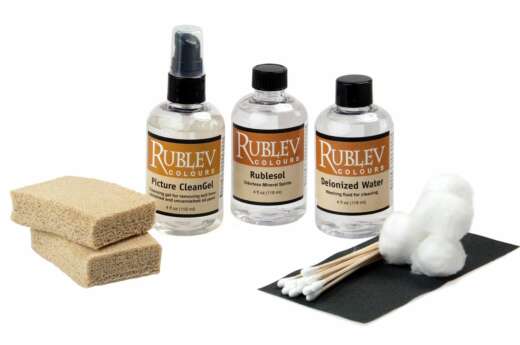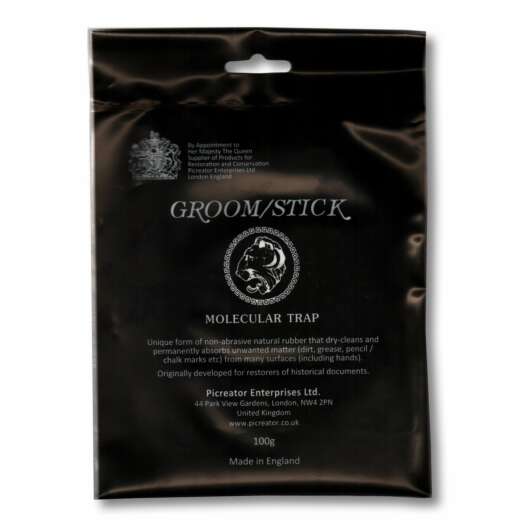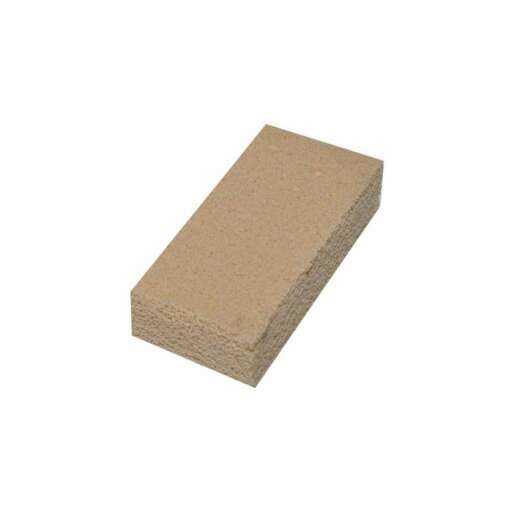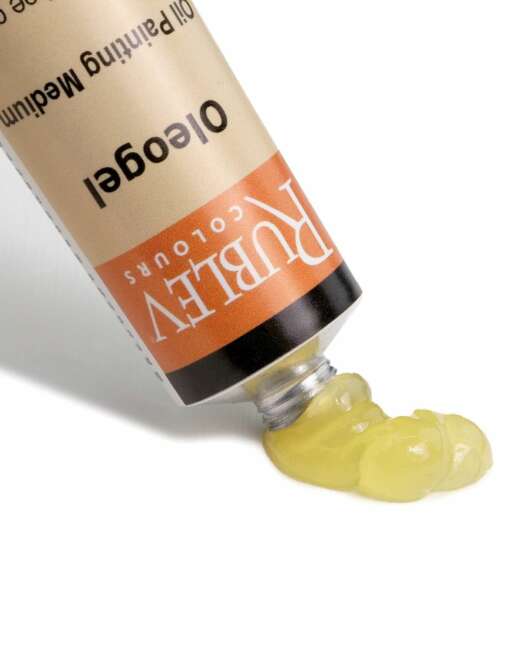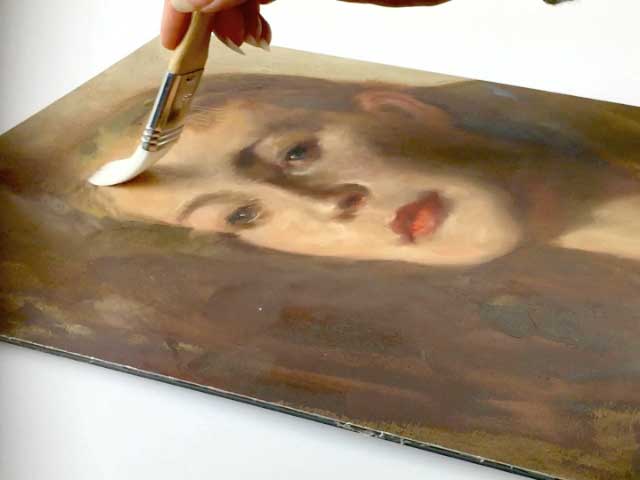
When dusting and dry cleaning methods do not remove dirt and grime from varnished or unvarnished paint surfaces, an aqueous cleaning method may be used as an alternative. Aqueous cleaning methods are more invasive than dusting and dry cleaning, so caution should be exercised when using these methods. Studies show that oil paint films are sensitive to water, primarily where the paint has been used to create a great range of surface effects (Tempest 2010). Aqueous foams and gels are currently used in conservation practice as an alternative to simply using water on paint surfaces (Heckenbücker 2010; Wolbers 2000; Stulik 2004).
Spit Cleaning Method
Using spit to clean a painting may seem absurd, but it’s a method used by professional conservators. Saliva has enzymes (α-amylase has been identified as a critical cleaning agent—Romao 1990) and chelating compounds that can help to remove dirt and grime, but that will not damage the paint.
Procedure
For this procedure, you will need cotton-tipped applicators or cotton balls.
-
Lightly wet the swab with your spit. Don’t soak the cotton, but wet enough to easily pick up any dirt particles.
-
Gently dab the wet cotton over the painting. Don’t move the cotton from side to side but up and down in small, soft dotting motions. Work a square inch at a time.
-
Wet the other end of the swab. Once the swab has picked up much dirt, it is no longer helpful. Discard the swab and wet a new one.
Keep a glass of water handy. It would be best if you worked slowly enough not to feel like you’re running out of saliva. If your mouth starts to dry, take a sip of water and wait a minute before returning for more spit.
with Picture CleanGel—an aqueous cleaning gel—contains all materials needed for dry and aqueous cleaning.
Water-Based Cleaning Solutions for Cleaning Paintings
Water and solvents are effective for removing dirt from picture surfaces, but they also penetrate the surface and potentially damage the layers of paint. Gels can reduce the penetration of cleaning solutions into paint layers and reduce mechanical stress on the surface during the cleaning process.
Another vital consideration in aqueous cleaning materials is to reduce the number of components such as solvents, surfactants, and other cleaning compounds that may potentially damage paint surfaces but also leave residues that can affect paint. Most household cleaning products (e.g., Windex) contain large amounts of surfactants, alcohol, ammonia, and other ingredients that can irreparably damage paint surfaces and leave residues that promote poor adhesion of subsequent paint layers or varnishes.

is a solvent-free aqueous gel cleanser that removes soil from varnished or unvarnished paint surfaces.
, made by Natural Pigments, is a solvent-free aqueous gel cleanser that is gentle on both varnished and unvarnished paint surfaces. Picture CleanGel comprises ultrapure deionized water with a low concentration of surfactants and chelating agents. The gel cleanser is designed to remove soil, proteinaceous (e.g., collagen glue), and carbohydrate (e.g., gums) materials from varnished and unvarnished oil paint surfaces. It is also helpful as a cleaner for unvarnished oil paintings that collect dirt and dust before varnishing.
Procedure
Read the directions carefully and proceed to use the product only according to these directions:
1. Pump a small amount of Picture CleanGel onto a soft-haired flat brush.
2. Apply the gel and stir momentarily on the surface with the brush.
3. Wipe away almost immediately with a dry cotton swab or cotton ball and allow it to dry completely. Roll the cotton swab on the surface to avoid rubbing the surface of the painting.
4. Rinse with deionized water and allow it to evaporate to dryness. Moisten the cotton swab or ball with deionized water and gently wipe the surface by rolling the cotton on the surface.
5. Rinse with mineral spirits in the same manner as the deionized water and allow it to evaporate to dryness.
CAUTION: Use the products in the Mini Picture Cleaning Kit only as directed. Test all products on an inconspicuous part of the painting before using it as directed. Use sparingly and only on dried oil paint or varnished surfaces. DO NOT USE ON ACRYLIC PAINT. When using water and mineral spirits to remove the residue from Picture CleanGel, test first on an inconspicuous paint surface area. On new oil paint surfaces, the mineral spirits may cause the lifting of pigment or paint. If this happens, use only deionized water to remove Picture CleanGel residue from the surface.
References
Heckenbücker, Anne and Demuth, Petra (2010) “Extended Abstract—Surface Cleaning with Aqueous Foams,” New Insights into the Cleaning of Paintings: Proceedings from the Cleaning 2010 International Conference, Marion F. Mecklenburg, A. Elena Charola, and Robert J. Koestler, Editors, Universidad Politécnica de Valencia, and Museum Conservation Institute, 2013, pp. 225–228.
Romao, Paula M.S., Alarcao, Adilia M., Viana, Cesar, A. N. (1990) “Human saliva as a cleaning agent for dirty surfaces.” Studies in Conservation, Volume 35, pp. 153–155.
Stulik, Dusan (2004) Solvent Gels for the Cleaning of Works of Art: The Residue Question, Dusan Stulik, V. Dorge, Editors, Getty Publications, 2004.
Tempest, Hannah; Burnstock, Aviva; Saltmarsh, Polly and van den Berg, Klaas Jan (2010) “Sensitivity of Oil Paint Surfaces to Aqueous and Other Solvents,” New Insights into the Cleaning of Paintings: Proceedings from the Cleaning 2010 International Conference, Marion F. Mecklenburg, A. Elena Charola, and Robert J. Koestler, Editors, Universidad Politécnica de Valencia, and Museum Conservation Institute, 2013, pp. 107–114.
Wolbers, Richard (2000) Cleaning Painted Surfaces: Aqueous Methods, Archetype Publications, 2000.



